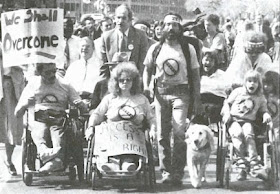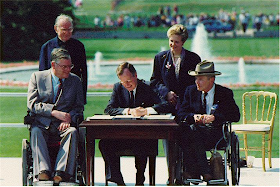by Samantha Garcia, CFILC's Office & Logistics Coordinator
![[In a large parking lot, people use their bodies to spell out ADA. Most people appear to use wheelchairs.]](https://blogger.googleusercontent.com/img/b/R29vZ2xl/AVvXsEjRRxfMcAtuZh0rGqdRM610W8r4ufs40qPdE9CEull4L2zDuzrNQ_O-NC6lds7G20BhWYSnxckX7nFhNYODsnScRfJ1yWn8yF9tCaH-6zphjyD-utIJkPANZHvHKSu2d0YNvcfSRvP-pA/s280/ada.jpg) |
Modeled after the Civil Rights Act of 1964, the ADA was the result of decades of work by thousands of people in the disability community and prohibits discrimination on the basis of disability in employment, state and local government, public accommodations, commercial facilities, transportation, and telecommunications.
Assistive technology (AT) plays a major role in helping
to realize the goals of the ADA. From reasonable accommodations for employees
to the many ways people with disabilities access communications, public
facilities and accommodations ("Assistive
Technology, Accommodations, and the Americans with Disabilities Act," Cornell
University).
Long before the ADA was first introduced in 1988, local
groups advocated for rights, parents fought against exclusions, and, as we know
well, the Independent Living movement was established – all making public the
discrimination and injustices people with disabilities had faced for so long.
 |
 |
There were wins and losses, but the disability
community was becoming a respected force and were acting as and seen as a
unified group, rather than separate groups of people with specific disabilities.
Importantly, the disability community also determined that those with
communicable diseases, such as AIDS, were to be included in this fight against
discrimination. Finally, inequality was starting to be seen for what it was and
changes were taking place.
Lawyers, advocates, negotiators, policy analysts, task
forces, networks, witnesses and legislators worked long and hard to create the
ADA and ensure it was enacted. Among many other measures, hearings were held
during which Senators, veterans, and community members spoke on the injustices
they had encountered, and thousands wrote their stories in letters that they
sent to be read at the hearings.
 |
On the day of the signing of the ADA, President Bush stated
that "we will not accept, we will not excuse, we will not tolerate
discrimination in America" ("ADA Signing Ceremony" http://www.ada.gov/videogallery.htm#anchor%20ADAsigning990).
We think of this as we honor and remember the work of those many who worked
tirelessly so we could celebrate the signing of the ADA as we do today, 23
years later. We still have a lot of work to do to ensure civil rights for us
all and we wage wars against inequality and discrimination: to protect children
from bullying; to ensure people with disabilities have full access to independence,
such as accessible and affordable housing; and to guarantee basic rights for
all Americans…but we know the way - we have done it before.
As we look back on our communities' accomplishments let us
not forget the assistive technology that allowed us to advocate for ourselves,
our children and our brothers and sisters with disabilities. Assistive
Technology is often an afterthought, but is critical to our livelihood, our
independence and our future.

No comments:
Post a Comment